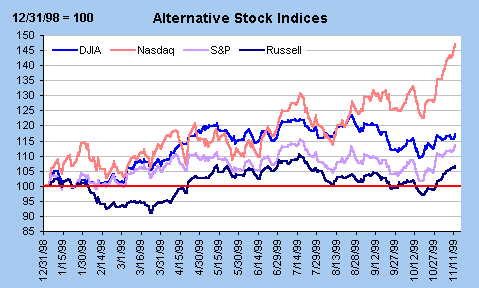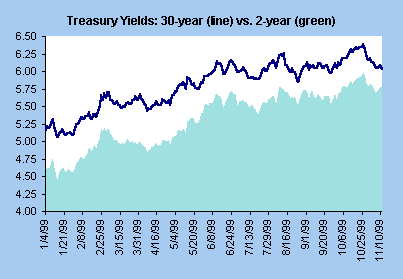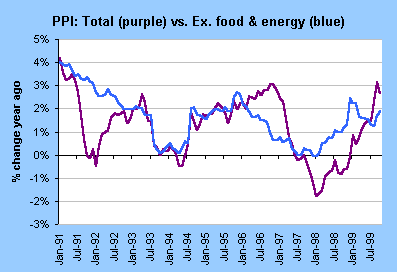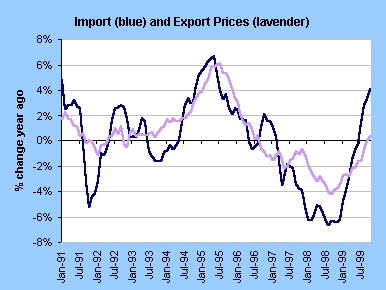
|
Today's Calendar |
| | Simply Economics |
| | International Perspective |
| | Resource Center |
 |
|
| 1999 Articles |
|
By Evelina M. Tainer Chief Economist, Econoday Productivity accelerates; NASDAQ in stratosphere
Dow makes a comeback on Friday and NASDAQ soars to new heights  The S&P 500 performed somewhat better than the Dow Jones Industrials this past week; this is helping to close the gap between these two measures. It is ironic that the Dow would tumble most of this past week, just as four new companies from the "new economy" were brought in to replace stodgy "old economy" companies. One would have expected the Dow to perform better. The Dow did stage a comeback on Friday with a 173 point surge. Market players were reacting not only to favorable economic news, but also the signing of the financial services reform bill which negates banking laws set in place during the 1930s.
Treasury market in tight range 
Productivity surprises on upside; unit labor costs on downside Unit labor costs increased at a modest 0.6 percent rate in the third quarter after zooming ahead at a 4.2 percent rate in the second quarter. Unit labor costs also softened on a year-over-year basis, rising 1.7 percent. The bottom-line on productivity? Productivity is the link between rising wage costs and moderate inflation. That is, wages can increases without incurring inflationary pressures as long as workers are more productive - i.e. producing more widgets by the hour. Fed chairman Alan Greenspan has conceded that productivity growth has been phenomenal in this cycle and helped to alleviate inflationary pressures thus far. The key question is one of degree. Productivity can certainly continue to increase. However, it must increase at an accelerating rate to maintain stable prices in the face of rising wages and tight labor markets. That is what the Fed chairman questions. Can productivity accelerate from here? This will be a point of debate at the FOMC meeting next Tuesday.
Inflation news less favorable  In both September and October, car prices increased sharply. According to the Labor Department, this had partly to do with quality adjustments. Despite the increases in the past two months, auto prices are only 0.3 percent higher than they were a year ago. Truck prices have risen slightly more, 1.3 percent, from a year ago. Perhaps this reflects consumers' fascination with mini-vans and sport utility vehicles. Tobacco prices were unchanged during the month, after an 8.4 percent spurt in September. Tobacco product prices are 37 percent higher than a year ago. (If that won't make someone quit smoking, what will?) Prescription drug prices was the other culprit - rising 1.2 percent in October. It seems that prices of generic drugs are now rising more rapidly. In past months, prices of name brands were surging. Looking at the chart above, it's hard to say that inflation is not an issue. Prices have generally headed higher for the past 18 months now. While higher energy costs have played a big role, one can't discount the trend entirely. After all, how many consumers can say they don't use gasoline or heating fuel?  The Labor Department also issued its monthly reading of import and export prices. While energy is the impetus behind rising import prices, on a year-over-year basis, this is just another sign of the times. There is no doubt that the best inflation news is behind us. The bottom-line on inflation? The inflation debate is not any less subtle than the productivity question. Will price increases at the producer level translate into higher prices paid by consumers? It is important to remember that only 75 percent of the PPI relates to only 43 percent of the CPI. That means accelerating producer prices may not translate into a galloping consumer price index. Most economists agree that the best inflation news is behind us. The question now is this: Will inflation accelerate or will prices settle in at about a 2 - 2 ¼ percent per year? Fed officials may be divided on this question - or not. The latest inflation news will probably be a negative factor for Fed officials who will be voting at the FOMC meeting next week.
Retail sales moderate  Consumers are feeling the impact of the two rate hikes that the Fed undertook this summer. In the past few months, we have already seen slower housing construction. In October, furniture sales decreased for the first time since January. The drop is in line with the slower pace of home sales. The bottom-line on consumer spending? Retail sales are not falling apart, but it does appear that consumer spending may be finally moderating after the gangbusters pace earlier in the year. Relative to a year ago, retailers may still find healthy gains for holiday sales. Yet, from month to month, we are likely to see consumer spending slowdown further as spending on consumer durables falls back, in line with softer housing activity. This is one factor that may alleviate Fed worries about an overheated economy.
THE BOTTOM LINE It is a close call as to whether Fed officials will decide to raise rates next week. From the market perspective, it may not make too much of a difference. If the Fed does raise rates, market players will view their job as complete and financial markets could stage a new rally. If the Fed doesn't raise rates, financial markets could stage a new rally. That is the irony of it.
Looking Ahead: Week of November 15 to 19
Monday
Tuesday The FOMC meeting will take place today. An announcement normally occurs at roughly 2:15 PM Eastern Time. Market players are gearing for a rate hike of 25 basis points in the federal funds rate.
Wednesday Market participants are expecting housing starts to decrease 1.1 percent in October to a 1.60 million unit rate. This would reinforce the downward trend that began a few months ago. Housing permits should rebound 4.9 percent to a 1.58 million unit rate.
Thursday Economists are predicting that the international trade balance on goods and services will worsen in September to $24.6 billion from a $24.1 billion shortfall in August. Most economists are looking for a drop in exports after last month's spurt. The Philadelphia Fed's business outlook survey is expected to increase in November to 10, from October's level of 6.9. Despite the uptick, this still keeps us below the September survey level. |
|||||||||||||||||||||||||||||||||||||||||||||||||||||||||||||||||||||||||||||||||||||||||||